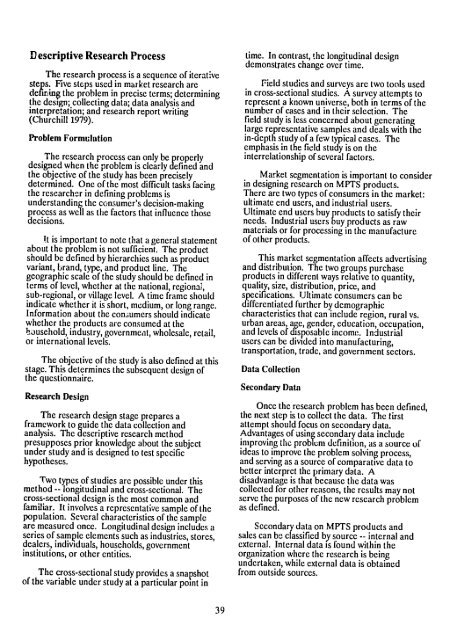multipurpose tree species research for small farms: strategies ... - part
multipurpose tree species research for small farms: strategies ... - part
multipurpose tree species research for small farms: strategies ... - part
You also want an ePaper? Increase the reach of your titles
YUMPU automatically turns print PDFs into web optimized ePapers that Google loves.
Descriptive Research Process<br />
The <strong>research</strong> process isa sequence of iterative<br />
steps. Five steps used in market <strong>research</strong> are<br />
deiring the problem in precise terms; determining<br />
the design; collecting datdataata analysis and<br />
interpretation; and <strong>research</strong> report writing<br />
(Churchill 1979).<br />
Problem Formulation<br />
The <strong>research</strong> process can only be properly<br />
designed when the problem is clearly defined and<br />
the objective of the study has been precisely<br />
determined. One of the most difficult tasks facing<br />
the <strong>research</strong>er in defining problems is<br />
understanding the consumer's decision-making<br />
process as well as the factors that influence those<br />
decisions.<br />
it is important to note that a general statement<br />
about the problem is not sufficient. The product<br />
should be defined by hierarchies such as product<br />
variant, brand, type, and product line. The<br />
geographic scale of the study should be defined in<br />
terms of level, whether at the national, regional,<br />
sub-regional, or village level. A time frame should<br />
indicate whether it is short, medium, or long range.<br />
In<strong>for</strong>mation about the conjumers should indicate<br />
whether the products are consumed at the<br />
hausehold, industry, governmeat, wholesale, retail,<br />
or international levels.<br />
The objective of the study is also defined at this<br />
stage. This determines the subsequent design of<br />
the questionnaire.<br />
Research Design<br />
The <strong>research</strong> design stage prepares a<br />
framework to guide the data collection and<br />
analysis. The descriptive <strong>research</strong> method<br />
presupposes prior knowledge about the subject<br />
under study and is designed to test specific<br />
hypotheses.<br />
Two types of studies are possible under this<br />
method -- longitudinal and cross-sectional. The<br />
cross-sectional design is the most common and<br />
familiar. It involves a representative sample of the<br />
population. Several characteristics of the sample<br />
are measured once. Longitudinal design includes a<br />
series of sample elements such as industries, stores,<br />
dealers, individuals, households, government<br />
institutions, or other entities.<br />
The cross-sectional study provides a snapshot<br />
of the variable under study at a <strong>part</strong>icular point in<br />
39<br />
time. In contrast, the longitudinal design<br />
demonstrates change over time.<br />
Field studies and surveys are two tools used<br />
in cross-sectional studies. A survey attempts to<br />
represent a known universe, both in terms of the<br />
number of cases and in their selection. The<br />
field study is less concerned about generating<br />
large representative samples and deals with the<br />
in-depth study of a few typical cases. The<br />
emphasis in the field study is on the<br />
interrelationship of several factors.<br />
Market segmentation is important to consider<br />
in designing <strong>research</strong> on MPTS products.<br />
There are two types of consumers in the market:<br />
ultimate end users, and industrial users.<br />
Ultimate end users buy products to satisfy their<br />
needs. Industrial users buy products as raw<br />
materials or <strong>for</strong> processing in the manufacture<br />
of other products.<br />
This market segmentation affects advertising<br />
and distribution. The two groups purchase<br />
products in different ways relative to quantity,<br />
quality, size, distribution, price, and<br />
specifications. Ultimate consumers can be<br />
differentiated further by demographic<br />
characteristics that can include region, rural vs.<br />
urban areas, age, gender, education, occupation,<br />
and levels of disposable income. Industrial<br />
users can be divided into manufacturing,<br />
transportation, trade, and government sectors.<br />
Data Collection<br />
Secondary Datat<br />
Once the <strong>research</strong> problem has been defined,<br />
the next step isto collect the data. The first<br />
attempt should focus on secondary data.<br />
Advantages of using secondary data include<br />
improving the problem definition, as a source of<br />
ideas to improve the problem solving process,<br />
and serving as a source of comparative data to<br />
better interpret the primary data. A<br />
disadvantage is that because the data was<br />
collected <strong>for</strong> other reasons, the results may not<br />
serve the purposes of the new <strong>research</strong> problem<br />
as defined.<br />
Secondary data on MPTS products and<br />
sales can be classified by source -- internal and<br />
external. Internal data is found within the<br />
organization where the <strong>research</strong> is being<br />
undertaken, while external data is obtained<br />
from outside sources.

















